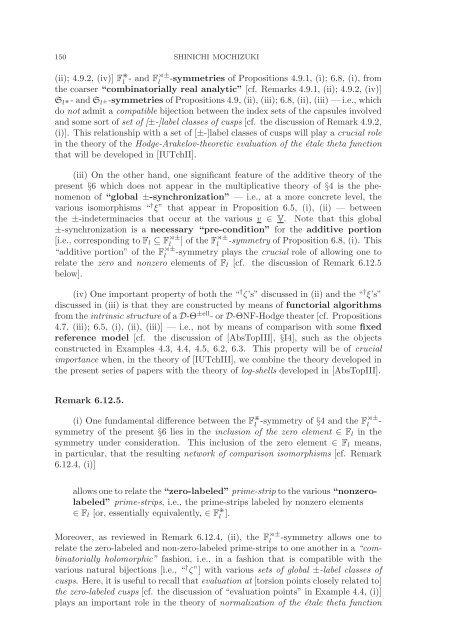Inter-universal Teichmuller Theory I: Construction of Hodge Theaters
Inter-universal Teichmuller Theory I: Construction of Hodge Theaters
Inter-universal Teichmuller Theory I: Construction of Hodge Theaters
Create successful ePaper yourself
Turn your PDF publications into a flip-book with our unique Google optimized e-Paper software.
150 SHINICHI MOCHIZUKI<br />
(ii); 4.9.2, (iv)] F l -andF⋊± l<br />
-symmetries <strong>of</strong> Propositions 4.9.1, (i); 6.8, (i), from<br />
the coarser “combinatorially real analytic” [cf. Remarks 4.9.1, (ii); 4.9.2, (iv)]<br />
S l -andS l ±-symmetries <strong>of</strong> Propositions 4.9, (ii), (iii); 6.8, (ii), (iii) — i.e., which<br />
do not admit a compatible bijection between the index sets <strong>of</strong> the capsules involved<br />
and some sort <strong>of</strong> set <strong>of</strong> [±-]label classes <strong>of</strong> cusps [cf. the discussion <strong>of</strong> Remark 4.9.2,<br />
(i)]. This relationship with a set <strong>of</strong> [±-]label classes <strong>of</strong> cusps will play a crucial role<br />
in the theory <strong>of</strong> the <strong>Hodge</strong>-Arakelov-theoretic evaluation <strong>of</strong> the étale theta function<br />
that will be developed in [IUTchII].<br />
(iii) On the other hand, one significant feature <strong>of</strong> the additive theory <strong>of</strong> the<br />
present §6 which does not appear in the multiplicative theory <strong>of</strong> §4 is the phenomenon<br />
<strong>of</strong> “global ±-synchronization” — i.e., at a more concrete level, the<br />
various isomorphisms “ † ξ” that appear in Proposition 6.5, (i), (ii) — between<br />
the ±-indeterminacies that occur at the various v ∈ V. Note that this global<br />
±-synchronization is a necessary “pre-condition” for the additive portion<br />
[i.e., corresponding to F l ⊆ F ⋊±<br />
l<br />
]<strong>of</strong>theF ⋊±<br />
l<br />
-symmetry <strong>of</strong> Proposition 6.8, (i). This<br />
“additive portion” <strong>of</strong> the F ⋊±<br />
l<br />
-symmetry plays the crucial role <strong>of</strong> allowing one to<br />
relate the zero and nonzero elements <strong>of</strong> F l [cf. the discussion <strong>of</strong> Remark 6.12.5<br />
below].<br />
(iv) One important property <strong>of</strong> both the “ † ζ’s” discussed in (ii) and the “ † ξ’s”<br />
discussed in (iii) is that they are constructed by means <strong>of</strong> functorial algorithms<br />
from the intrinsic structure <strong>of</strong> a D-Θ ±ell -orD-ΘNF-<strong>Hodge</strong> theater [cf. Propositions<br />
4.7, (iii); 6.5, (i), (ii), (iii)] — i.e., not by means <strong>of</strong> comparison with some fixed<br />
reference model [cf. the discussion <strong>of</strong> [AbsTopIII], §I4], such as the objects<br />
constructed in Examples 4.3, 4.4, 4.5, 6.2, 6.3. This property will be <strong>of</strong> crucial<br />
importance when, in the theory <strong>of</strong> [IUTchIII], we combine the theory developed in<br />
the present series <strong>of</strong> papers with the theory <strong>of</strong> log-shells developed in [AbsTopIII].<br />
Remark 6.12.5.<br />
(i) One fundamental difference between the F l<br />
-symmetry <strong>of</strong> §4 andtheF⋊±<br />
l<br />
-<br />
symmetry <strong>of</strong> the present §6 lies in the inclusion <strong>of</strong> the zero element ∈ F l in the<br />
symmetry under consideration. This inclusion <strong>of</strong> the zero element ∈ F l means,<br />
in particular, that the resulting network <strong>of</strong> comparison isomorphisms [cf. Remark<br />
6.12.4, (i)]<br />
allows one to relate the “zero-labeled” prime-strip to the various “nonzerolabeled”<br />
prime-strips, i.e., the prime-strips labeled by nonzero elements<br />
∈ F l [or, essentially equivalently, ∈ F l ].<br />
Moreover, as reviewed in Remark 6.12.4, (ii), the F ⋊±<br />
l<br />
-symmetry allows one to<br />
relate the zero-labeled and non-zero-labeled prime-strips to one another in a “combinatorially<br />
holomorphic” fashion, i.e., in a fashion that is compatible with the<br />
various natural bijections [i.e., “ † ζ”] with various sets <strong>of</strong> global ±-label classes <strong>of</strong><br />
cusps. Here, it is useful to recall that evaluation at [torsion points closely related to]<br />
the zero-labeled cusps [cf. the discussion <strong>of</strong> “evaluation points” in Example 4.4, (i)]<br />
plays an important role in the theory <strong>of</strong> normalization <strong>of</strong> the étale theta function
















